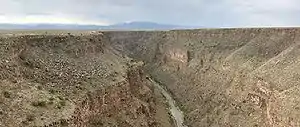Taos Plateau volcanic field
The Taos Plateau volcanic field is an area of extensive volcanism in Taos County, New Mexico, United States. It is the largest volcanic field in the Rio Grande Rift, spreading over 7,000 km2. The age of most of the vents and associated lava flows in the field is estimated to be between 1.8 and 4 million years, with a few 22-million-year-old vents. The composition of the lavas varies from tholeiitic basalt to rhyolite. Landforms include sheet flows, cinder cones, and shield volcanoes. The sheet flows of the Servilleta Basalt are well-exposed in the Rio Grande Gorge carved by the Rio Grande.[1] The highest point of the field is San Antonio Mountain at 10,908 feet (3,325 m).

Notable vents
The field contains at least 35 vents, arranged in a rough concentric pattern 50 kilometers (31 mi) across. The central part of the field is the most mafic, consisting of tholeiitic basalt shield volcanoes, with andesite vents further out and rhyodacite vents in the outer part of the field. Two small rhyolite domes in the center of the field are exceptions to this pattern.[2]
| Name | Elevation | Location | Last eruption | |
| meters | feet | Coordinates | ||
| San Antonio Mountain[3] | 3,325 | 10,908 | 36°51′34″N 106°01′7.3″W | - |
| Ute Mountain[3] | 3,076 | 10,093 | 36°56′14″N 105°41′02″W | - |
| Cerro de la Ollaute mountain[3] | 2,887 | 9,475 | 36°45′21″N 105°47′55″W | - |
| Cerro del Aire[3] | 2,750 | 9,023 | 36°43′08″N 105°55′03″W | - |
| Cerro Chiflo | 2,736 | 8,978 | 36°44′54″N 105°42′35″W | - |
| Guadalupe Mountain North | 2,688 | 8,820 | 36°44′27″N 105°37′36″W | - |
| Guadalupe Mountain South | 2,658 | 8,722 | 36°43′00″N 105°38′56″W | - |
| Cerro Montoso[3] | 2,638 | 8,655 | 36°40′24″N 105°46′04″W | - |
Origin
The field lies near the intersection of the Jemez Lineament with the Rio Grande rift. Here hot mantle rock has bulged upwards into the rift, allowing a high degree of decompressional melting to produce the tholeiitic magmas. The outer zone of andesites and rhyodacites is interpreted as a lower degree of melting, while the two rhyolite domes are interpreted as resulting from fractional crystallization of magma in the shallow crust.[2]
References
- "Taos Plateau Volcanic Field | New Mexico Museum of Natural History & Science". www.nmnaturalhistory.org. Retrieved 2018-10-13.
- Lipman, Peter W.; Mehnert, Harald H. (1979). "The Taos Plateau Volcanic Field, Northern Rio Grande Rift, New Mexico". Special Publications: 289–312. doi:10.1029/SP014p0289. ISBN 9781118664988.
- Julyan, Robert Hixson (2006). The Mountains of New Mexico. UNM Press. p. 368. ISBN 0826335160.
Further reading
- Wood, Charles A.; Kienle, Jürgen, eds. (1990). Volcanoes of North America. Cambridge University Press. pp. 290–292. ISBN 0-521-43811-X.
